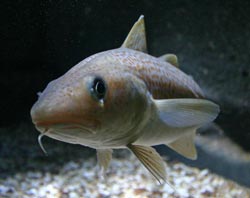Cod has a key role in the whole Baltic Sea

A new investigation put in evidence the key role of cod as regulator of the whole Baltic Sea ecosystem. Photo: Roger Jansson<br>
The study shows that when the cod population in the central Baltic increases, it spreads into larger areas and spills over into adjacent marginal systems where it usually does not occur, as for example the Gulf of Riga.
On the other hand, when the cod population size in the central Baltic decreases, it concentrates into the southern Baltic Sea and disappears from the other systems where it cannot reproduce. Cod population size and spatial expansions/contractions in the Baltic landscape depend on fishing pressure and hydro-climatic conditions in the central Baltic that acts as source of cod for the more coastal and northern areas.
The presence/absence of cod in the Gulf of Riga impacts the whole local ecosystem, from the main pelagic fish, the herring, to the zooplankton and phytoplankton through a “trophic cascade”. The presence of cod in the Gulf of Riga can therefore decrease the intensity of the local algal blooms. However, other local factors also affect the Gulf of Riga ecosystem, as local fishing on cod and herring, temperature and river runoff transporting nutrients into the Gulf.
This study increases our knowledge on the predators’ effects on ecosystem structure, and stresses the importance of linking both local and regional processes for a full understanding of ecosystem functioning on a broader landscape scale. Investigations on the functional implications of cross-system fluxes of organisms are central in the management of exploited resources and ecosystem conservation.
SLU-researcher Michele Casini was the leader of the study in collaboration with other scientists from Sweden, Denmark, Latvia, Germany and Norway. The analysis is based on biological and hydrological data collected in the Baltic Sea during a 35-year period.
The results of the study have been published early edition online in the scientific journal Proceedings of the National Academy of Sciences of the USA, 13 April 2012, with the title Predator transitory spillover induces trophic cascades in ecological sinks.
Contacts and more information:
Researcher Michele Casini: link to my SLU personal website:
http://www.slu.se/sv/fakulteter/akvatiska-resurser/organisation/personliga-sidor/michele-casini/
SLU, Department of Aquatic Resources, Institute of Marine Research, Lysekil.
Phone: +46 010-478 40 16, e-mail: michele.casini@slu.se
Media Contact
More Information:
http://www.vr.seAll latest news from the category: Ecology, The Environment and Conservation
This complex theme deals primarily with interactions between organisms and the environmental factors that impact them, but to a greater extent between individual inanimate environmental factors.
innovations-report offers informative reports and articles on topics such as climate protection, landscape conservation, ecological systems, wildlife and nature parks and ecosystem efficiency and balance.
Newest articles

High-energy-density aqueous battery based on halogen multi-electron transfer
Traditional non-aqueous lithium-ion batteries have a high energy density, but their safety is compromised due to the flammable organic electrolytes they utilize. Aqueous batteries use water as the solvent for…

First-ever combined heart pump and pig kidney transplant
…gives new hope to patient with terminal illness. Surgeons at NYU Langone Health performed the first-ever combined mechanical heart pump and gene-edited pig kidney transplant surgery in a 54-year-old woman…

Biophysics: Testing how well biomarkers work
LMU researchers have developed a method to determine how reliably target proteins can be labeled using super-resolution fluorescence microscopy. Modern microscopy techniques make it possible to examine the inner workings…





















